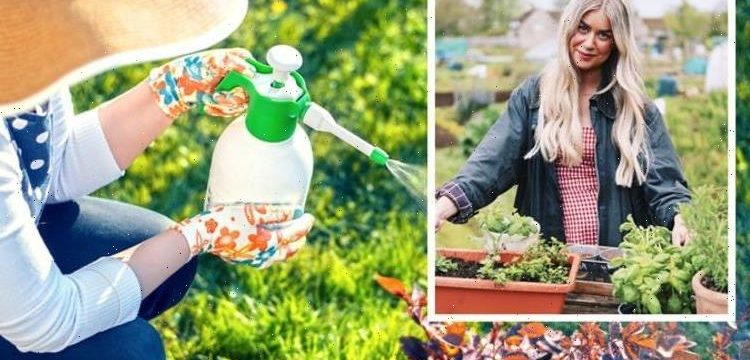This Morning: Daisy Payne gives advice on tackling weeds
We use your sign-up to provide content in ways you’ve consented to and to improve our understanding of you. This may include adverts from us and 3rd parties based on our understanding. You can unsubscribe at any time. More info
While summer may be drawing to a close, bugs and insects are not hibernating just yet. Express.co.uk spoke to Daisy Payne, a self-confessed amateur gardener and allotment holder who has been presenting segments on ITV’s This Morning, about alternatives to pesticides. Here are her easy, cheap and eco-friendly methods to rid your garden of pests without harming them or your plants.
What are pesticides?
A pesticide is any substance used to kill, repel, or control certain forms of plant or animal life that are considered to be pests.
Pesticides include herbicides for destroying weeds and other unwanted vegetation, insecticides for controlling a wide variety of insects and fungicides used to prevent the growth of molds and mildew.
Disinfectants are also a pesticide and they can be used to prevent the spread of bacteria, and compounds used to control mice and rats.
Why are pesticides bad for the environment?
Pesticides are poisons and, unfortunately, they can harm more than just the pests at which they are targeted.
They are toxic, and exposure to pesticides can cause a number of health effects.
They are also linked to a range of serious illnesses and diseases from respiratory problems to cancer.


Daisy said: “I don’t use pesticides, and again this is all part of bringing small changes into our lives so we are considering the environment, and our natural world.
“Changes such as how our homes are heated right through to peat-free composts and not using pesticides.
“There are some really, easy [and] cost effective – cheap things that we can do as alternatives to pesticides.”
Daisy’s pesticide alternatives
No-dig method
“For me, the no dig method is fantastic,” Daisy explained.
“If you’ve got a really weedy garden or my allotment for example is full of weeds, I use the no dig method, which is layering up cardboard.
“Let’s face it, we’ve all got loads of cardboard because everything’s coming in cardboard these days.
“Layering the cardboard up, dampen it down by watering it and then add compost on top.
“That is a fantastic, instant way of getting rid of weeds and using the space you have.”

Soap spray
“Another thing to do to try and get rid of pests is soap spray,” the presenter added.
“Soap spray is a great way to control aphids, which can really ruin plants, and it just moves them on, it doesn’t do any damage to them.
“You just mix up a spray with some soap and some water – make sure it’s mild, and that can help to get rid of those bugs but not kill them off like the pesticide does.”
The majority of households will have washing up liquid or hand soap, and this spray solution will cost pennies.
Horticultural grit
“The other thing I would say to do to get rid of pest is using grit,” Daisy said.
“Get a horticultural bag of grit and put it around young plants in the spring is a really good way of protecting them but doing absolutely no harm.
“It’ll keep slugs away from your plants, but it’s doing absolutely no harm to the environment so that’s a little top tip as well.”
Horticultural grit can also be put on top of soil on indoor plants and can instantly transform the look of the plan too, as well as deterring aphids.

About Daisy
“I got into gardening about five years ago when I moved from London to the Cotswolds and said goodbye to the city and I was actually was lucky enough to buy my first house,” she revealed.
“It’s a new build house and it was very much presented with what is essentially a mud patch for a garden [and that’s how] I started to get into gardening because suddenly, you had to take this mud patch and make it look like a garden.
“So, I have over the last few years learned everything I know from that journey and I’ve transformed what was the mud patch into now, what I like to think is a very cute, nice little garden,” Daisy added.
“I’ve learned loads along the way and getting into it as a complete beginner, I started to share what I was doing on social [media], on Instagram.”
Speaking about why she wanted to share her gardening journey, Daisy said: “When I was first getting into gardening, I found it really, really hard to find anybody who was just talking about the basics with no jargon, and in really straightforward, simple terms.
View this post on Instagram
A post shared by Daisy Payne (@gardentogarnish)
“There’s obviously some incredible gardeners, we’re so blessed with some national treasures for gardeners in the UK, but it was actually really, really hard to just find out the simple stuff and I thought ‘You know what, if I can share some of that some of my journey and some of my learnings, then hopefully I’ll inspire more people to not feel like there are any barriers to getting into it’.
“It has helped me so much, gardening is more than just gardening,” Daisy continued. “It’s about being healthy in body and mind.
“It was last year, that first lockdown, when I found people were in their homes more and we were all dealing with so much stuff, that gardening, just really felt even more relevant and relevant to people who hadn’t maybe tried gardening before and that’s where it all started for me.
“And I don’t profess to be an expert, but I am a really passionate gal who wants to get loads more people like me into gardening because there’s so much to enjoy.”
Source: Read Full Article
